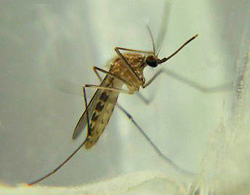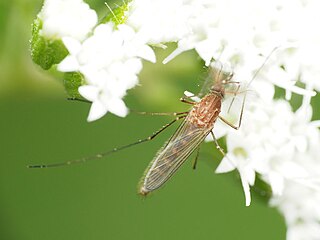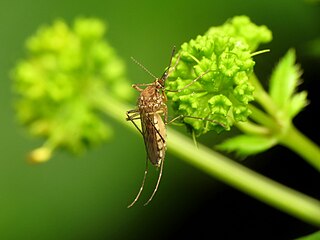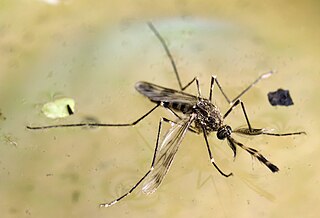
Mosquitoes are approximately 3,600 species of small flies comprising the family Culicidae. The word "mosquito" is Spanish for "little fly". Mosquitoes have a slender segmented body, one pair of wings, one pair of halteres, three pairs of long hair-like legs, and elongated mouthparts.

Aedes albopictus, from the mosquito (Culicidae) family, also known as the (Asian) tiger mosquito or forest mosquito, is a mosquito native to the tropical and subtropical areas of Southeast Asia. In the past few centuries, however, this species has spread to many countries through the transport of goods and international travel. It is characterized by the white bands on its legs and body.

Arbovirus is an informal name for any virus that is transmitted by arthropod vectors. The term arbovirus is a portmanteau word. Tibovirus is sometimes used to more specifically describe viruses transmitted by ticks, a superorder within the arthropods. Arboviruses can affect both animals and plants. In humans, symptoms of arbovirus infection generally occur 3–15 days after exposure to the virus and last three or four days. The most common clinical features of infection are fever, headache, and malaise, but encephalitis and viral hemorrhagic fever may also occur.

Culex or the typical mosquitos are a genus of mosquitoes, several species of which serve as vectors of one or more important diseases of birds, humans, and other animals. The diseases they vector include arbovirus infections such as West Nile virus, Japanese encephalitis, or St. Louis encephalitis, but also filariasis and avian malaria. They occur worldwide except for the extreme northern parts of the temperate zone, and are the most common form of mosquito encountered in some major U.S. cities, such as Los Angeles.

Culiseta is a genus of mosquitoes. Most Culiseta species are cold-adapted, and only occur in warmer climates during the colder parts of the year or at higher elevations where temperatures are lower. Species found in Southern California are larger than most mosquitoes species, specifically Cs. inornata, Cs. particeps, and Cs. incidens. These species are found throughout the year in Southern California and feed on several vertebrate species, such as birds, livestock, rodents, reptiles, and humans. The larvae of most species are found bogs, marshes, ponds, streams, ditches, and rock pools, but an African species occurs in tree holes ("phytotelmata"), a common eastern Palaearctic species occurs in water wells and rock pools, and several Australian species occur under ground. Little is known about the blood-feeding habits of females. Most species feed on birds and mammals, but a few feed on reptiles. Several species attack domestic animals and occasionally humans, and some species are pollinators.

Culex pipiens, commonly referred to as the common house mosquito, is a species of mosquito. House mosquitoes are some of the most common mosquitoes. More specifically, Culex pipiens is considered as the northern house mosquito, as it is the most common mosquito to the northern regions of the US. North of the 39th parallel north in the US, only C. pipiens are present, whereas south of the 36th parallel north, only C. quinquefasciatus are present. Additionally, they can be found in both urban and suburban temperate and tropical regions across the world.

Culex restuans is a species of mosquito known to occur in Canada, the United States, Mexico, Guatemala, Honduras, and the Bahamas. It is a disease vector for St. Louis encephalitis and West Nile virus. In 2013 West Nile Virus positive specimens were collected in Southern California.

Aedes vexans, the inland floodwater mosquito or tomguito, is a cosmopolitan and common pest mosquito. This species has been collected in southern California.

Culex tarsalis, also known as Western Encephalitis Mosquito, is a mosquito species that appears in southern California. The species has black and white banding on the legs.

Culex quinquefasciatus, commonly known as the southern house mosquito, is a medium-sized mosquito found in tropical and subtropical regions of the world. It is a vector of Wuchereria bancrofti, avian malaria, and arboviruses including St. Louis encephalitis virus, Western equine encephalitis virus, Zika virus and West Nile virus. It is taxonomically regarded as a member of the Culex pipiens species complex. Its genome was sequenced in 2010, and was shown to have 18,883 protein-coding genes.
Culex erythrothorax is a species of mosquito that appears in Southern California. It is also known as the tule mosquito due to its preference for breeding in tule plants. The species has a brownish-orange color. It is a confirmed vector of West Nile virus.

Culex nigripalpus is a species of medium-sized, dark, blood-feeding mosquito of the family Culicidae.

Anopheles freeborni, commonly known as the western malaria mosquito, is a species of mosquito in the family Culicidae. It is typically found in the western United States and Canada. Adults are brown to black, with yellow-brown hairs and gray-brown stripes on the thorax. Their scaly wings have four dark spots, which are less distinct in the male.

Culiseta incidens, the cool weather mosquito, is a species of mosquito in the family Culicidae. Specimens have been collected in Southern California.

Culiseta inornata, the winter marsh mosquito, or the unadorned American cool weather mosquito is a species of mosquito in the family Culicidae. This species is found in southern California.

Anopheles franciscanus is a species of mosquito in the family Culicidae. This species has been collected in southern California.
Culex thriambus is a mosquito species that appears in the southwestern United States, including Southern California, Texas, as well as in Mexico. It is a confirmed vector of West Nile virus. The majority of host species the mosquito takes blood from are in the order Passeriformes.
Sister Monica Asman (1920-2016) was an American Catholic nun and research scientist at University of California, Berkeley. She applied genetic methods to mosquitoes with the aim of reducing their ability to carry viruses that can cause disease in humans and animals, and to reduce the size of mosquito populations. She also opened the St. Francis Center of Redwood City for the poor.
Culiseta particeps is a species of mosquito in the family Culicidae. It is found along the West coast of the United States including Southern California, Arizona as well as Mexico and Guatemala. Cs. particeps is not a known vector of human pathogens.

Anopheles hermsi is a species of mosquito in the family Culicidae. It is a known vector of Plasmodium vivax malaria. An. hermsi have been collected in Southern California.














